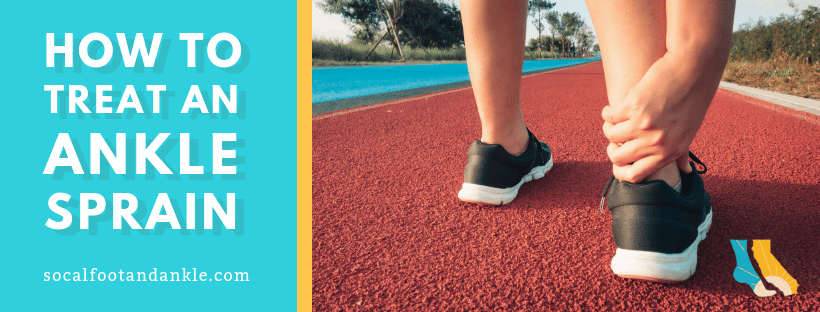A New Twist on Ankle Sprains
Maybe your little girl jumped off the playground equipment at Oso Viejo Community Park (you told her not to do that!) and landed funny on her left foot. Could be your son slid into second base in his Little League game and jammed his ankle against the bag. Or maybe you finally got a night out without the kids and fell off your 4” stilettos on the dance floor, and now you have an ankle sprain.
There are many causes of sprains that can happen to hundreds of people every day. The question is, what do you do now?
RICE to the Rescue—or Maybe Not?
For years the basic go to has been the RICE method. The acronym stands for Rest, Ice, Compression, and Elevation, and involves home treatments of staying off the foot and using ice therapy, an elastic compression wrap, and lifting it above heart level to reduce pain and swelling. Limited study has been done on these therapies, so there is no conclusive scientific proof that they are the optimal way to treat this injury.
It is true that this therapy does reduce pain, and it also keeps fluids from collecting around the ankle—as long as it remains elevated. So far so good, but what about healing the damage done by the injury and regaining full use of the joint?
To understand how to treat sprains most effectively, let’s take a closer look at what happens when you sprain your ankle.

Understanding Ankle Sprains
Your foot and leg bones are connected at your ankle. The joint is intricately formed for a variety of movements, and the separate bones are held together by strong bands of tissue called ligaments. This keeps the range of motion in the joint within certain parameters.
What happens with this injury is that the foot twists or turns farther than normal, and those ligaments are stretched too far. That causes them to lose elasticity, develop small tears, or even rupture completely. The amount of damage divides sprains into three grades—from mildly stretched ligaments that still allow you to walk on the foot, to a severe tear that makes it too painful for you to bear any weight.
Along with some degree of pain and swelling, there may also be bruising from damaged blood vessels. The joint can stiffen up and be hard to move. It can also become loose and unstable, so the bones move out of position and cause great discomfort when you try to stand or walk.
New Thoughts on Resting a Sprain
For now, most podiatrists still think reducing pain and swelling is a good thing, so the ICE part of the therapy is still recommended. However, experts are rethinking the idea of complete rest for the damaged joint.
Many times full recovery from an ankle sprain can take months or even years, and even then, it may never be as good as before. Bad sprains have often been treated with plaster splints that kept the ankle immobile for a week or ten days. But just as with other fields of medicine like childbirth and surgery, researchers are now thinking there may be benefits to moving around earlier than was recommended before.
That doesn’t mean that you should ignore a bad sprain and hobble around in extreme pain. It means that you should come in and let us determine the extent of your injury and guide you through proper treatment.
Sure, use RICE treatment until your appointment, but then let us supervise a return to activity with range of motion exercises and gradual increase in weight-bearing. Supervised exercise could possibly be the difference between a long recovery and chronic problems down the road, and quicker healing with fewer long term consequences.
Ladera Ranch Podiatrists for a Sprained Ankle
If you or your child has this injury, start RICE and call Southern California Foot & Ankle Specialists for an appointment. Reach our Ladera Ranch office in California by dialing (949) 364-9255 (WALK) or filling out the contact form on our website. We will do our best to make sure that your joint heals properly and strongly to get you back to the activities you enjoy.
Contact Us
Ladera Ranch
333 Corporate Dr. Ste 230, Ladera Ranch, CA 92694
Tel: (949) 364-9255 (WALK)
Fax: (949) 364-9250
Office Hours:
Monday - Friday: 9am - 5pm
*(Lunch 12 noon - 1pm)
Orange
2617 E Chapman Ave. Ste 303, Orange, CA 92869
Tel: (714) 639-7993
Fax: (714) 639-0729
Office Hours:
Monday - Friday: 9am - 5pm
*(Lunch 12 noon - 1pm)
